Clancy Tucker's Blog, page 140
September 20, 2018
21 September 2018 - Aung San Suu Kyi - Burmese Activist

Aung San Suu Kyi - Burmese Activist -
G'day folks,
Aung San Suu Kyi is a Burmese politician, diplomat, and author, and Nobel Peace Prize laureate. She is the leader of the National League for Democracy and the first and incumbent State Counsellor, a position akin to a prime minister.
Aung San Suu Kyi AC born 19 June 1945 in Rangoon, is a pro-democracy activist and leader of the National League for Democracy in Burma. During the military control of Myanmar, she was a noted prisoner of conscience and advocate of nonviolent resistance. For many years (1989-2010) she was held under house arrest. However, on her release, she led the National League for Democracy and serves as the first and incumbent State Counsellor, a position akin to a Prime Minister. From 2016, she has come under international criticism for failing to stem the persecution of the Rohingya people in Rakhine State on the border with Malaysia.

Aung San Suu Kyi was born on 19 June 1945 in Rangoon (then British Burma). She is the third child in her family. Her name is derived from three relatives; “Aung San” from her father, “Kyi” from her mother and “Suu” from her grandmother. Her father, Aung San, was instrumental in negotiating independence from Britain in 1947. He also founded the Burmese army and was assassinated by political rivals in late 1947.
Suu Kyi studied at primary schools in Rangoon, before studying in India (graduating from New Delhi University, 1964) and St Hugh’s College, Oxford University (1968). After Oxford University, she worked for the United Nations for three years. In 1972 she married Michael Aris who was living in Bhutan – they had two children.
In 1988 she returned to Burma to visit her ailing mother but became caught up in the 1988 uprising as protests against the Burmese Junta sprang up around the country. Suu Kyi became active in supporting the League for Democracy and soon became promoted to a prominent position in the movement.
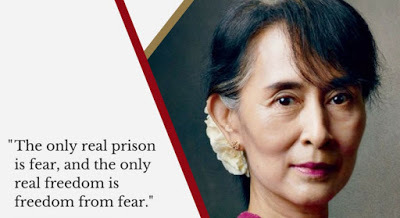
Around this time her husband was diagnosed with terminal cancer, but he was not allowed an entry visa to the country, however, despite her husband’s ailing health Suu Kyi was reluctant to leave now she had a prominent position in the movement for democracy.
In 1989, she was placed under house arrest by the military junta. She was told she could have freedom if she agreed to leave the country, but she preferred to stay. Under house arrest, she spent time studying Buddhism and political activism and remained popular with those who supported the ideals of democracy in Myanmar.
For her principled, non-violent protest against the military and support for democratic principles, she was lauded by many human rights groups and influential bodies around the world. Suu Kyi won the Rafto Prize and the Sakharov Prize for Freedom of Thought in 1990 and the Nobel Peace Prize in 1991. In 1992, she was awarded the Jawaharlal Nehru peace prize by the Government of India for her peaceful and non-violent struggle under a military dictatorship.
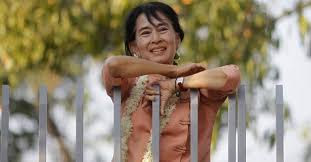
For many years she was kept under house arrest, with the Burmese junta repeatedly extending her detention. According to the results of the 1990 general election, Suu Kyi earned the right to be Prime Minister, as leader of the winning National League for Democracy party, but her detention by the military junta prevented her from assuming that role.

She is frequently called Daw Aung San Suu Kyi; Daw is not part of her name, but an honorific similar to madam for older, revered women, literally meaning “aunt”. Strictly speaking, her given name is equivalent to her full name, but it is acceptable to refer to her as “Ms. Suu Kyi” or Dr. Suu Kyi, since those syllables serve to distinguish her from her father, General Aung San, who is considered to be the father of modern-day Burma. The U2 album All That You Can’t Leave Behind was banned in Burma because one of the songs (Walk On) was written about her struggle and how, even when the government threatened her, she “walked on” the other way.
In 2010, she was released from house arrest and travelled around the world speaking up for democracy in Burma. In the summer of 2012, she received an honorary doctorate from Oxford University. (Aung San Suu Kyi studied PPE at St Hugh’s College, Oxford University)
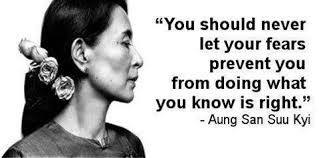
On 2 May 2012, she was elected to the National Parliament with other Democrat MPs. In 2015, her party, the National League for Democracy won a sweeping victory, although she was ineligible for the Presidency (due to provisions which prevented widows and mother of foreigners.) She claimed she would hold the real power in the new government. The president, Htin Kyaw, created a new role for her – the position of State Counsellor on 1 April 2016. This enabled her to assume the dominant position in the government.
In December 2016, the United Nations strongly criticized the Myanmar government for its poor treatment of the Rohingya people, and called its approach “callous” and warned of possible crimes against humanity. The United Nations called on Aung San Suu Kyi to end her silence and stand up for the oppressed Rohingya minority.

On 4 September 2017, the UN’s released a report on human rights in Myanmar. It criticised Suu Kyi’s response arguing that given reports of crimes against innocent people in Rohingya villages “The de facto leader needs to step in – that is what we would expect from any government, to protect everybody within their own jurisdiction.”
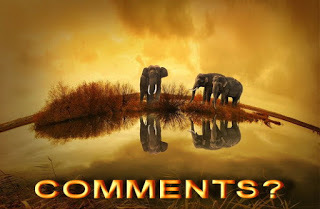
Clancy's comment: I've always admired her struggle against fairly big odds. However, her recent silence regarding the Rohingya people is somewhat disturbing, considering her long struggle for democracy,
I'm ...


Published on September 20, 2018 13:53
September 19, 2018
20 September 2018 - THE AFRICAN CIVET
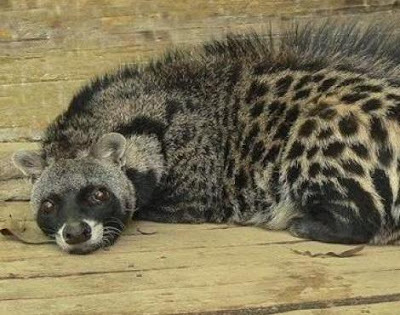
THE AFRICAN CIVET
G'day folks,The African civet is the largest representative of the African Viverridae and the sole member of its genus. It is considered common and widely distributed in sub-Saharan Africa.
African Civet Classification and Evolution
The African Civet is a large speciesof Civet found across sub-Saharan Africa. The African Civet is the only remaining member in its genetic group and is considered to be the largest Civet-like animal on the African continent. Despite their cat-like appearance and behaviours, the African Civets are not felines at all but are in fact, more closely related to other small carnivoresincluding Weaselsand Mongooses. The African Civet is most well known for the musk that it secretes to mark its territory(called Civetone), which has been used in the manufacturing of perfumes for centuries, and its striking black and white markings, make the African Civet one of the easiest Civet speciesto identify.

African Civet Anatomy and Appearance
One of the African Civet's most distinctive featuresare the black and white markings on their fur and grey face, which along with the black band around their eyes, gives these animals a Raccoon-like appearance. The similarity is only heightened by the fact that the African Civet's hind legs are quite a bit longer than the front legs, making its stance very different to that of a Mongoose. The average adult African Civet has a body length of around 70cm with nearly the same length tail on top of that. The paws of the African Civet each have five digitswith non-retractable claws to enable the Civet to move about in the trees more easily.
African Civet Distribution and Habitat
The African Civet is found in a variety of habitats on the African continent, with its range extending from coast to coast in sub-Saharan Africa. African Civets are most commonly found in tropical forests and jungles and areas where there is plenty of dense vegetation to provide both cover and animalsthat the African Civets feeds on. African Civets are never found in arid regions and always must be in an area which has a good water source. Despite this though, it is not uncommon for African Civets to be found along rivers that lead into the more arid regions. They are capable swimmers and often spend their time hunting and resting in the trees as well as on the ground.

African Civet Behaviour and Lifestyle
The African Civet is a solitary animalthat only comes out under the cover of night to hunt and catch food. These nocturnalanimals are primarily tree-dwelling creatures that spend most of the daylight hours resting in the safety of the trees high above. African Civets tend to be most active just after sunset but tend to hunt in areas that still provide plenty of cover. Despite being generally very solitary creatures, the African Civet has been known to gather in groups of up to 15 members particularly during the mating season. They are also highly territorial animals, marking their boundaries with the scent released by their perineal glands.
African Civet Reproductionand Life Cycles
The only time when African Civets seem to be seen together is when they are mating. The female African Civet usually gives birth to up to 4 young after a gestation periodthat lasts for a couple of months. The female African Civet nests in an underground burrow that has been dug by another animal in order to safely raise her young. Unlike many of their carnivorous relatives, Civet babies are usually born quite mobile and with their fur. The babies are nursed by their mother until they are strong enough to fend for themselves. African Civets can live for up to 20 years, although many rarely get to be this old.

African Civet Diet and Prey
Despite the fact that the African Civet is a carnivorous mammal, it has a very varied diet that consists of both animaland plant matter. Small animalssuch as Rodents, Lizards, Snakes and Frogs make up the majority of the African Civet's diet, along with Insects, berries and fallen fruits that it finds on the forest floor. The African Civet predominantly uses its teeth and mouth to gather food instead of using its paws. This method of eating means that the African Civet can use its 40 sharp teeth effectively to break its catch down, and the strong jaw of the African Civet makes it harder for its meal to try and escape.
African Civet Predatorsand Threats
Despite being a secretive yet a relatively ferocious predator, the African Civet is actually preyed upon by a number of other predatorswithin their natural environment. Large predatory Cats are the most common predatorsof the African Civet including Lions and Leopards along with reptilessuch as large Snakesand Crocodiles. African Civet populations are also under threat from both habitatloss and deforestation, and have been subject to trophy hunters in the past, across the continent. One of the biggest threats to the African Civet is the want for their musk.
African Civet Interesting Facts and Features
The musk secreted by the glands close to the African Civet's reproductive organshas been collected by Humansfor hundreds of years. In its concentrated form, the smell is said to be quite offensive to people, but much more pleasant once diluted. It was this scent that became one of the ingredients in some of the most expensive perfumes in the world (and made the African Civet a well-known African animal). African Civets are known to carry the rabies disease, which is contracted through contact with an already infected animal. The African Civet is also known to use designated areas around its territory, where it is able to go to the toilet.

African Civet Relationship with Humans
Each African Civet secretes up to 4g of musk every week, which is normally collected from African Civets in the wild. However, the capturing and keeping of African Civets for their musk is not unknown and is said to be an incredibly cruel industry. Today, few perfumes still contain actual musk from the glands of an African Civet as many scents today are easily reproduced artificially. Although it is a protected yet not an endangered animal, the African Civet populations have also been severely affected by Human hunters, who hunt these little carnivoresto simply add their skin to the trophy cabinet.
African Civet Conservation Statusand Life Today
Today, the African Civet is under threat from deforestation and therefore drastic loss of much of its natural habitat. The main reason for such extensive deforestation in the area is either for logging or to clear the land to make way for palm oilplantations. The African Civet is listed as being Least Concern, which means that there is little threat at the moment that the African Civet will become extinctin the near future.

Clancy's comment: I'd never heard of these creatures before, and it's interesting that they secrete musk, and carry rabies.
I'm ...


Published on September 19, 2018 13:54
September 18, 2018
19 September 2018 - THE MEMBERSHIP CAFES OF PROVENCE

THE MEMBERSHIP CAFES OF PROVENCE
G'day folks,
Welcome to a sophisticated lifestyle.
T he village of Gordes in Provence is one of the most beautiful & charming in a part of France that’s teeming with small towns that are … well, beautiful and charming. Perched high on the slopes of the Monts de Vaucluse, Gordes is a treasure trove of narrow, winding cobbled streets, crammed with old homes that cling to the mountainside, and lead up to an old medieval castle. But in one corner of this magical village overlooking the Calavon Valley is a tiny bar that’s one of the last of its kind in France– the Cercle Republicain! The what now? Pull up a chair and pour yourself a virtual glass rosé as we investigate these old fashioned cafés, once found all over France, that operated on a “members-only” only basis.
 Members of these almost-forgotten establishments were mostly local working men and artisans, who would meet in these small club houses to discuss the values of the French Republic, whilst sipping cheap drinks, and worrying over the threats posed by the church, surviving royalists and the Prussian menace.
Members of these almost-forgotten establishments were mostly local working men and artisans, who would meet in these small club houses to discuss the values of the French Republic, whilst sipping cheap drinks, and worrying over the threats posed by the church, surviving royalists and the Prussian menace.Once, the Cercle Républicains thrived throughout France, but especially in Provence. At one point there were over 700 in the southern department of Vaucluse alone. In the tiny village of Gordes, with a population of just 2,000, there used to be thirteen Cercle Republicains, such was their popularity.
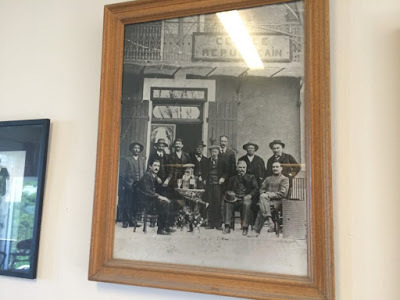
Today however there are sadly just twenty six left in all of France.The Cercle Républicain in Gordes was voted into being in April 1912. To venture inside today, you still have to become a member. The €5 ‘carte annuelle’ membership fee however is a small price to pay for what lies inside.
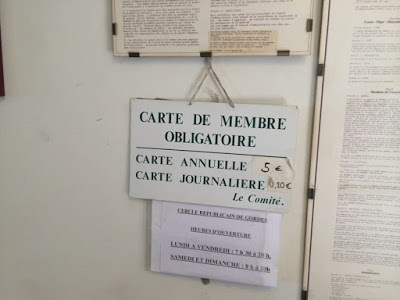
The hundred year old bar leads onto a small balcony that commands breathtaking views over the valley below. The Cercle Républicain de Gordes is plainly decorated, and filled with mostly elderly villagers, quietly enjoying their subsidised drinks.
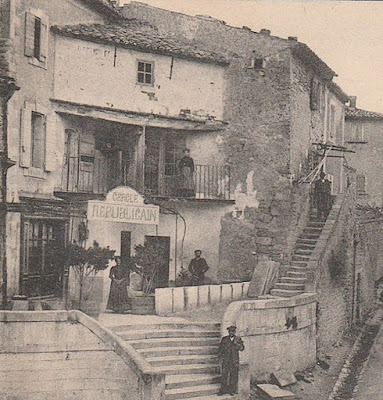
Indeed not much seems to have changed inside a Cercle Républicain from a scene recorded by Eugen Weber in his book Peasants Into Frenchmen, where he describes one sequestered away in a quiet side street in Carpentras, just north of Avignon; “Around a table sit a dozen peasants, their staffs beside them, drinking their coffee. A handsome young man….reads aloud an article from the Monarchist newspaper. He stops at almost every sentence to explain it in Provençal……here is the urban club at work.”

Today, just as in 1912, the Cercle Républicain in Gordes provides privacy, easy access to newspapers, and perhaps above all, cheaper drinks and longer opening hours than the other bars in the picturesque mountain top village.But the century old rules still apply – there is still a voted in president, vice president, secrétaire and trésorier.



Clancy's comment: I'm interested in becoming a member.
I'm ...


Published on September 18, 2018 13:59
September 17, 2018
18 September 2018 - GEORGE ORWELL
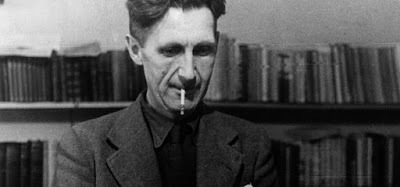
GEORGE ORWELL
G'day folks,
Now, here's a thought-provoking author. George Orwell, (25 June 1903 – 21 January 1950) has proved to be one of the twentieth century’s most influential and thought-provoking writers. His relatively small numbers of books have created intense literary and political criticism.
Orwell was a socialist, but at the same time, he did not fit into any neat ideology. He is best known for his novels “1984” and “Animal Farm” – which both warn about the dangers of a totalitarian state. Completed just after the Second World War, they touched a chord because of contemporary fears over the growing influence of state control. He was foremost a political writer, but for Orwell, his object was not to promote a certain point of view but to arrive at the truth; exposing the hypocrisy and injustice prevalent in society.
Orwell’s Early life
Orwell was born Eric Blair on 25 June 1903, in Motihari, Bihar, in India. Shortly after his birth, he was taken by his mother back to Oxfordshire, England. His family were financially poor, but an aspiring middle-class family. Orwell described it as ‘lower-upper-middle-class’ – a reflection of the importance he felt the English attached to class labels.
With his family unable to afford fees to a proper public school, he was educated at St Cyprian’s in Eastbourne, which served as a preliminary crammer to gaining a scholarship for public schools like Eton. In a later essay “Such, Such were the Joys” he was scathing of his time at St Cyprian’s noting how difficult it was to be happy in such a mean-spirited environment. Aged 14, he was able to move to Eton, where he had better memories because of the greater intellectual stimulation. However, the awareness of being much poorer than many of his school friends remained. He left Eton with firmly held “middle class” values but at the same time a sense of unease with his social position.

After school, he was unable to afford university, and for want of a better option, Orwell took a job with the Burmese civil service. It was here in Burma, that Orwell would begin to assert his independence from his privileged upbringing. Revealingly, Orwell later told how he found himself rooting for the local population, and despising the imperial ideology which he represented. He resigned from his position in 1927.
It was in the nature of George Orwell to try and see a situation from other people’s point of view. He was unhappy at accepting the conventional social wisdom. In fact, he grew to despise his middle-class upbringing so much he decided to spend time as a tramp. He wanted to experience life from the view of the gutter. His vivid experiences are recorded in his book “Down and out in Paris and London”. No longer could Orwell be described as a “Champagne Socialist”; by living with the poorest and underprivileged, he gained a unique insight into the practical workings of working class ideas and working-class politics.

The Road to Wigan Pier
In the middle of the great depression, Orwell undertook another experience travelling to Wigan; an industrial town in Lancashire experiencing the full effects of mass unemployment and poverty. Orwell freely admitted how, as a young child, he was brought up to despise the working class.
The Road to Wigan Pieroffered a penetrating insight into the condition of the working classes. It was also a right of passage for Orwell to live amongst the people he had once, from a distance, despised. The Road to Wigan Pier inevitably had a political message, but characteristically of Orwell, it was not all pleasing to the left. For example, it was less than flattering towards the Communist party. This was despite the book being promoted by a mostly Communist organisation – The Left Book club.

Orwell and the Spanish Civil War It was fighting in the Spanish Civil war that Orwell came to really despise Communist influences. In 1936, Orwell volunteered to fight for the fledgeling Spanish Republic, who at the time were fighting the Fascist forces of General Franco. It was a conflict that polarised nations. To the left, the war was a symbol of a real socialist revolution, based on the principles of equality and freedom. It was for these ideals that many international volunteers, from around the world, went to Spain to fight on behalf of the Republic. Orwell found himself in the heart of the Socialist revolution in Barcelona. He was assigned to an Anarchist – Trotskyist party – P.O.U.M. More than most other left-wing parties, they believed in the ideal of a real Marxist revolution. To members of the P.O.U.M, the war was not just about fighting the Fascist menace but also delivering a Socialist revolution for the working classes. In his book, “Homage to Catalonia” Orwell writes of his experiences; he notes the inefficiency with which the Spanish fought even wars. He was enthused by the revolutionary fervour of some of his party members; however, one of the overriding impressions was his perceived betrayal of the Republic, by the Stalinist backed Communist party.
Unwittingly he found himself engaged in a civil war amongst the left, as the Soviet Union backed Communist party turned on the Trotskyite factions like P.O.U.M. In the end, Orwell narrowly escaped with his life, after being shot in the throat. He was able to return to England, but he had learnt at first hand how revolutions could easily be betrayed; ideas that would later shape his seminal work “Animal Farm.”
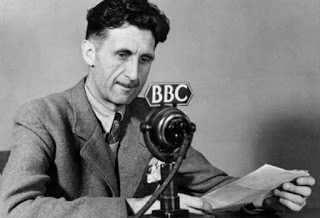
During the Second World War, Orwell was declared unfit for active duty. He actively supported the war effort from the start. (He didn’t wait for the Soviet Union to enter like some communists.) He also began writing for the left-leaning magazine ‘The Tribune’ which was associated with the left of the Labour Party. Orwell was appointed editor and was enthusiastic in supporting the radical Labour government of 1945, which implemented a national health service, welfare state and nationalisation of major industries. However, Orwell was not just focused on politics, he took an active interest in working class life and English culture. His short essays investigated aspects of English life from fish and chips to the eleven rules of making a good cup of tea.
Orwell described himself as a secular humanist and could be critical of organised religion in his writings. However, he had a fondness for the social and cultural aspect of the Church of England and attended services intermittently.
He married Eileen O’Shaughnessy in 1936 and in 1944, they adopted a three-week old child – Richard Horatio. Orwell was devastated when Eileen died and sought to remarry – seeking a mother for his young son. He asked several women for their hand in marriage, with Sonia Branwell accepting in 1949 – despite Orwell’s increasingly poor health. Orwell was a heavy smoker and this affected his lungs causing bronchial problems. In the last years of his life, he moved to a remote farm on the Scottish island of Jura to concentrate on his writings. Orwell passed away on 21 January 1950. His friend David Astor helped him to be buried at Sutton Courtenay churchyard, Oxfordshire.
The two great novels of Orwell were “Animal Farm” and “1984”. Animal Farm is a simple allegory for revolutions which go wrong, based primarily on the Russian revolution. 1984 is a dystopian nightmare about the dangers of a totalitarian state which gains complete control over its citizens.

Clancy's comment: Certainly an interesting character.
I'm ...

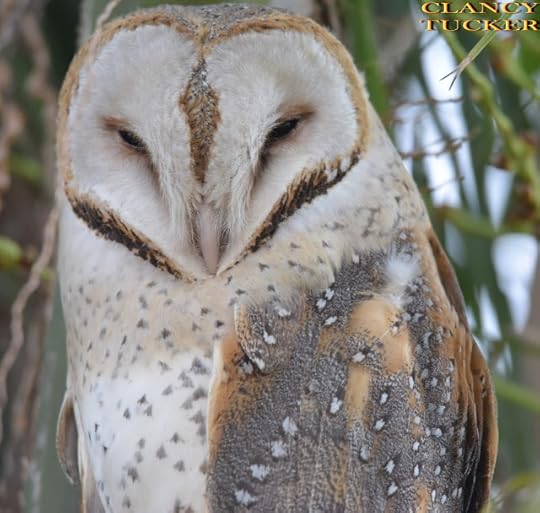
Published on September 17, 2018 13:57
September 16, 2018
17 September 2018 - THE FASHIONS AT WIMBLEDON
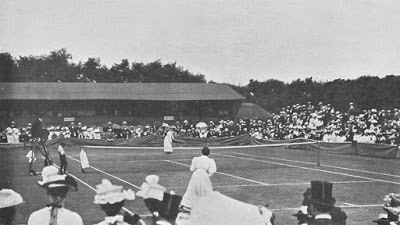
THE FASHIONS AT WIMBLEDON
G'day folks,
Wimbledon today is known for showcasing the tennis talents of both male and female competitors, with household names ranging from Andy Murray to the Williams sisters to Marina Sharapova. It is astonishing to think that in the tournament’s earlier days, women were expected to make a decent serve dressed in full-length skirts, corsets, and a bulky shirt: the ‘tennis whites’ of the time. It took some real champions to make a name for women in tennis.
At the turn of the century, there really wasn’t much to differentiate a female tennis player from the average lady walking down the street to do her groceries. Corsets, petticoats and floor-length skirts were just part of the game. At the time, the officials at Wimbledon were mostly concerned with preserving the ‘modesty’ of these top athletes – something which might seem a little irrelevant to us today. The ladies on the court did look very prim and proper, but their outfits probably weren’t the best choice for pursuing that Grand Slam, or even returning a couple of balls. It isn’t hard to see why women were consistently outperformed by their male counterparts when they were weighed down by weighty skirts, shirts, belts – and don’t forget the statement hat.

Unperturbed by the dress code, meet the formidable British athlete Dorothea Douglass Lambert Chambers, who dominated Wimbledon in the early 20th century. Douglass made her first appearance at Wimbledon in 1900, looking sharp with a shirt and tie on the court. It’s hard to imagine playing tennis in that dress, but Dorothea was up to the challenge – she went on to win seven Wimbledon Women’s Single titles, and even won the gold medal at the 1908 Summer Olympics.

Douglass also pretty much wrote the rule book on female tennis fashion. In 1910, she wrote Lawn Tennis for Ladies, containing advice for female players including court etiquette, dress code, and the correct equipment needed to emulate Dorothea’s tennis prowess. A pretty impressive side-project for a tennis champion and Olympic gold-medalist.
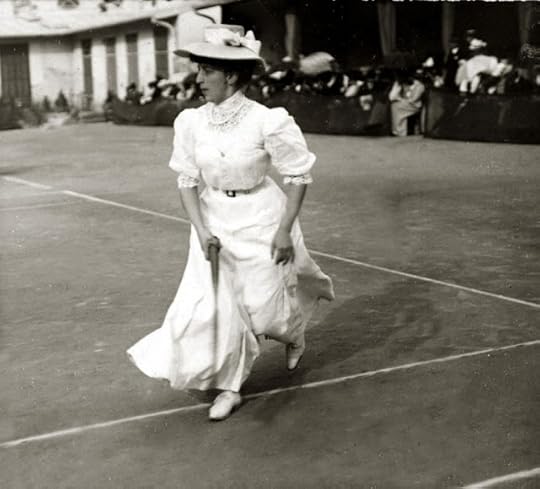
After Douglass, French competitor Suzanne Lenglen made a name for herself as tennis’ favourite flapper and a prima donna in the 1920s. Her antics on the court kept the audience on their toes. Lenglen was known to swap her court-side drink for a swig of brandy, and always played with a full face of makeup, which she managed to keep intact despite being known to break down and cry during a bad game.
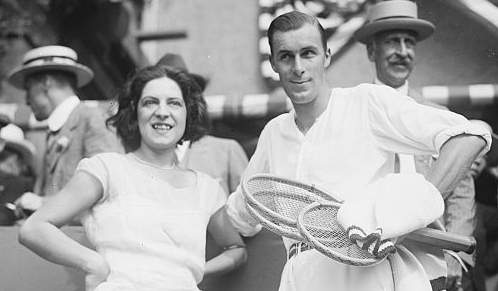
American tennis champion Bill Tilden commented on Lenglen that, “her costume struck me as a cross between a prima donna’s and a streetwalker”. Despite attracting media attention through her ostentatious clothes and dramatic personality, Lenglen became known for her grace and talent on the court. She dominated women’s tennis in the Roaring ’20s, with a personality to match the period. She earned the respect of the tennis community and became a household name, opening up the game for future generations of women.

Tennis trends were challenged once again after WWII. In 1949, the tennis player Gertrude Moran caused a stir during her first appearance at Wimbledon, receiving the more memorable nickname ‘Gorgeous Gussie’. After winning the singles, women’s doubles and mixed doubles categories at the US indoor championships, the Californian athlete, who preferred to be known as Gussy, shocked the crowd and officials at Wimbledon with her ‘revealing’ tennis whites.

Before the tournament, Moran had approached the official Wimbledon host Ted Tinling to design her outfit, originally asking for sleeves and a skirt in block colours. Because of Wimbledon’s rule that outfits had to be white only, Tinling instead agreed to design an alternative outfit. Tinling’s skirt seemedan appropriate length when Gussy walked onto the court, but as soon as play began, onlookers were shocked by Gussy’s frilly knickers on full display.

The All England Club’s committee chastised Moran for bringing “vulgarity and sin into tennis”. Even politicians at the time got their knickers in a twist, and questions over appropriate clothing were raised in Parliament. Tinling was cast out of the Wimbledon community for 33 years, despite his long career as an official Wimbledon host. However, due to the sensationalist nature of the story and Gussy’s attractive figure, she was an instant hit with the media and public.
 Clancy's comment: Ah, the old days, eh? And, I wonder how much they were paid compared to today's prima donnas.
Clancy's comment: Ah, the old days, eh? And, I wonder how much they were paid compared to today's prima donnas.I'm ...


Published on September 16, 2018 13:15
September 15, 2018
16 September 2018 - DAVE STOKES - SPECIAL GUEST AUDIO BOOK PUBLISHER

DAVE STOKES - SPECIAL GUEST AUDIO BOOK PUBLISHER -
G'day folks,
Today, I am pleased to introduce a man in the audio book industry. Below, you will see the covers of some of the books Dave has turned into magical audio books, and don't forget to check out his videos.
Welcome, Dave ...
1. WERE YOU A GOOD READER AS A KID?
Hopeless! And really, the same throughout my adult life (with the exception of text books – stuff I HAVE to read). I’ve never felt that joy of curling up with a good book. In the audio publishing game, my customers are all authors, who not only enjoy reading, but are advocates for the written word. I’ve decided to ‘fess up’ to them all from the get-go. It can be an awkward moment, usually accompanied with rather glib responses like “Riiight…”, “Okaaay…” and “Hmmm…”. I guess storytelling (aural learning) is how I engage with and continue to understand my world. That - along with a love of playing and listening to music – made audiobooks a pretty good fit.
2. WHEN AND HOW DID YOU BECOME AN AUDIOBOOK PUBLISHER?
author2audio commenced in September 2017, shortly after I finished an IT contract. At the time, a friend and social media expert, was singing the praises of voice advocate and futurist – Gary Vaynerchuk. “With your music, recording and technology background Dave, why not offer a mobile audiobook recording service?” I couldn’t think of a single objection, and have been enjoying the development of the business and meeting authors across a huge diversity of subject matter ever since.

3. WHY AN AUDIOBOOK PUBLISHER?
Apart from a love of all things audio, there seemed to be two obstacles for authors: 1. Extreme prices and 2. A perception that authors outside the US or UK could not publish and receive royalties from Audible and iTunes. It appears that authors are paying up to a 300% premium for in-studio recording, production and publication. My service is mobile. I come to the author. It avoids costly studio overheads, and at the same time I ensure a high quality, ‘background noise free’ professionally produced recording. Soft furnishings, in a carpeted room with drapes is ideal, so a dining room or home office is perfect. Through my association with an international distributor, the audiobook can be for sale on Audible, iTunes and 20 + other online retail and library outlets within a month. Royalty payments go directly to the author’s PayPal account. So both myths busted!
4. WHAT DO YOU ENJOY MOST ABOUT BEING AN AUDIOBOOK PUBLISHER?
By far and away the most enjoyable step in the audiobook publication process is recording the author’s narrative. All have been experts in their field, public speakers, podcasters and workshop facilitators. I hear their book once during recording, again during editing and a third time during the final ‘listen through’ after production. It’s a great free education and supports informed blog posts and articles to help the author promote their audiobook. I take lots of notes during the recording process and help the author with pronunciation. There is a huge value in reading the audiobook to an audience (of one) – it brings out the storyteller by encouraging expression, persuasion and enthusiasm.
5. WHAT IS THE HARDEST THING ABOUT YOUR JOB?
I guess there are two things that challenge me: the constant quest to promote the service and perfecting techniques for reducing breaths in recordings. Although Australian and other non US and UK authors can now easily publish to Audible and iTunes (and get paid!), the last three of four years has seen them ‘park’ their audiobook projects. I want them to know I can help. I’m constantly perfecting techniques for quieting breaths. It’s an optimum, as in not completely removed (which can make you sound like a robot!), and not so loud that you sound like an asthmatic! Gentle breaths allow a warm consistency when listening on headphones or earpieces.
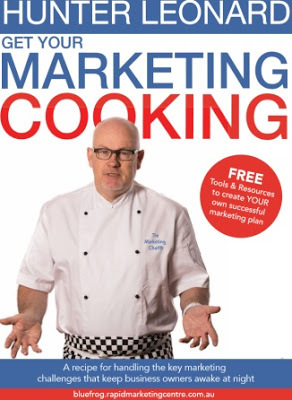
6. WHAT WERE YOU IN A PAST LIFE, BEFORE YOU BECAME A PUBLISHER?
I have always been interested in music, and have played drums in and recorded bands since my early twenties. During that same time I have also enjoyed a career in technology, working for computer networking companies and stockbrokers. I guess I found my ‘sweet spot’ by finding right and left brain joy in audio.
7. HOW MANY BOOKS HAVE YOU PUBLISHED?
I’ve published 10 audiobooks since my business got started in September 2017, so about one per month up to now (June 2018). I have also ventured into podcasting production, author interview recording and audio visual tours.
8. WHAT ARE YOU READING AT THE MOMENT?
‘The armchair guide to property investing (how to retire on $2,000 a week) by Ben Kingsley and Bryce Holdaway. We are scheduled to record the audiobook of same in July 2018.
9. WHAT INSPIRES YOU AS A PUBLISHER?
Again, not being an avid reader, the thought of bringing an audience to listen to an audiobook during their daily commute is very motivating. The largest growth market is young men, who are also voraciously consuming podcasts. I feel a kindred spirit!
10. DO YOU PREFER TO PUBLISH A PARTICULAR GENRE’? WHY?
My authors so far have written business books designed to inform, extend brand awareness and promote their expertise. Although all subject matter is appropriate for the audiobook format, some content is particularly well amplified. The books on business storytelling, voice coaching and executive presentation skills are a particularly good fit. For instance, describing to the listener how to use your diaphragm to project your voice is conveyed infinitely better by vocal expression, rather than text and diagrams! I am looking forward to producing some novels in audio, which have so far eluded me, but I know some wonderful voice actor narrators who can pull off dozens of character voices.
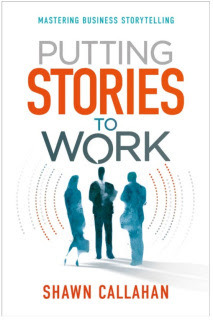
11. DO YOU HAVE ANY TIPS FOR NEW WRITERS?
One of the book publishers I am working with has a great common sense method for getting your book underway. It can be tough to sit down with paper and pen, and ‘go’! An alternative is to pick say, 10 subjects that you can and want to talk about. Record a spiel about each topic straight into the voice recording app on your smart phone. Have each recording transcribed. By the end of the process, you have 10 chapters that are 80% complete and require minimal editing. This technique transitions beautifully to audio, because you have written simply in a conversational and intimate tone.
12. DO YOU HAVE A FAVOURITE PLACE TO WORK?
Being a mobile service, I’m constantly on the move for recording. It’s great to be welcomed into people’s homes, and I enjoy the comfort the author feels by recording in their own space. When it comes to editing, a quiet place is essential. The final ‘listen through’ of the audiobook is probably the most challenging. I’m actively listening to the book for the third time. Despite laying on the couch being a comfortable option, two hour stints with a break sitting at a desk stops me from getting too dozy!
13. WHAT IS YOUR GREATEST JOY IN PUBLISHING A MANUSCRIPT?
It’s all about the author having another publishing format to share their story.
14. WHO IS YOUR FAVOURITE ALL TIME AUTHOR. WHY?
Graham Greene. I read ‘The Quiet American’ whilst at school and have never felt so absorbed in a story since. I am fascinated with concepts like social justice, colonial power and belief systems. I love his ‘detached observer’ perspective, where questions of action and involvement resonate with the proposition that ‘no person is an island’.
15. WHAT’S THE GREATEST COMPLIMENT YOU EVER RECEIVED FROM A CLIENT?
One of my authors was particularly adamant about recording themselves on their own equipment. The experience was very challenging despite our best intentions, discussions and advice. Recording venues included: a noisy CBD apartment, a bedroom, basement carpark (a short time after beginning, construction works began on the site next door!) and ended with a three day cottage retreat to the mountains among the screeching Galahs. It was mortifying. The editing process took three weeks. After completion of the audiobook, we both reflected on our existential, ‘Sisyphus like’ experience. The author was amazed and delighted with the result, but reflected this was going to be a ‘one time only’! We’ll see whether in fact ‘time does heal all wounds’.
16. WHAT WAS THE WORST COMMENT FROM A CLIENT?
Publishing is a ‘shot gun’ approach to extending your influence and promoting your stories and expertise. You are relying on ‘pulling’ your customer toward you (rather than using a ‘push’ strategy). After a long and involved exchange with a financial services author, discussing these brand benefits, the pitch came to an abrupt halt after a breakeven analysis. “Why would I waste my time and money?” was the author’s closer. It was a good lesson in understanding the difference between an author who derives all their income from book sales, versus a writer who is using their audiobook to promote their professional services, expertise and influence. It’s a big ask’ to have your cake and eat it too’.

17. DO SOME OF YOUR CLIENTS FRUSTRATE YOU?
Not really. There can be a long sales lead time, but this just means making sure you have plenty of irons in the fire (like most businesses). Most are committed to the idea of an audiobook before I first speak to them, so they are more likely to be frustrated with me when I don’t inhibit my sales pitch, when all they want is to just set aside a date for recording!
18. WRITERS ARE SOMETIMES INFLUENCED BY THINGS THAT HAPPEN IN THEIR OWN LIVES. ARE YOU AS A PUBLISHER?
I guess the most important skill in the audiobook game is active listening. I’ve always had an auditory learning preference. It was a great moment of empathy when I discussed this with a sales manager I once knew. He would never make eye contact when chatting, presenting or thinking. Couldn’t help myself and called him on it one day. He said: “I really don’t concentrate very well when gazing at others. Listening is how I learn best!” I realised that I had the same preference, especially when trying to absorb something complex.
19. OTHER THAN PUBLISHING, WHAT ELSE DO YOU LOVE?
Dinner parties, with a few reds getting to know others. My favourite thing! I’m mad for documentaries and love a good biography.
20. DO YOU ALSO WRITE?
It’s a work in progress. I’m working on a do it yourself guide to recording and publishing your audiobook currently. It’s a bit like Doctor’s children always being sick… too busy making audiobooks to find the time to write something that will save me time!
21. ARE SOME MANUSCRIPTS DIFFICULT TO REVIEW? WHY?
The beauty of creating audiobooks is that all the editing has been done previously. Apart from tripping over the occasional complex sentence (which reads fine in your inner voice), authors read their books very well. As you would imagine, it’s much easier to read your own writing.
22. DESCRIBE YOUR PERFECT DAY.
Viewing documentaries and binge watching a Netflix series with my beloved)
23. WHAT ARE YOUR PLANS FOR THE FUTURE?
As far as the audiobook business is concerned, I would like to contact as many book publishers as possible and become their preferred supplier. I’m chatting to a publisher in Dubai at the moment, with a view to popping over for a couple of weeks and recording a dozen authors while I am there. There are a few authors in Tasmania who will be done in the same way.

24. DO YOU HAVE MUCH TO DO WITH OTHER PUBLISHERS?
The small number of publishers I have met so far, have found most of their work with self-published authors. It’s great to meet for coffee and a chat at regular intervals. It’s good to get together and discuss publication options for an industry that is changing very rapidly. Some authors are releasing their audiobooks prior to their eBooks and paperbacks. Very disruptive.
25. HOW DO YOU SEE PUBLISHING IN GENERAL? POSITIVE?
Absolutely! My favourite quote for those thinking about publishing a book is: “It’s a business card on steroids!” I feel the greatest challenges for authors is in the promotion of their book and expertise. With self-publishing becoming incredibly popular, you need some way to ‘cut through the noise’. By identifying your target market first, you can leverage your social media with author interviews, blogging, speaking and podcasts – all of which point to your ‘publication triangle’ – paperback, eBook and audiobook.
26. WHAT’S YOUR VIEW ON E-BOOKS AND AUDIOBOOKS VERSUS TRADITIONAL BOOKS.
After participating in an author’s Facebook poll, I realised that most readers still covet the time to curl up with a good book. About 20% were pure audiobook listeners. Others used a combination, in particular those who were travelling (or got car sick). They would resume a paperback on audio during long haul flights or car travel interstate. For aged and disabled folks, where vision is less than perfect, an audiobook with earphones fits the bill. The Google Home’s, Amazon Echo’s and Apple Siri’s of this world are enabling – particularly aged couples – to share their storytelling time (and have a talking calendar with prompts for ‘bin night’ .)
27. IS THERE ANY ONE THING THAT ‘SMACKS YOU IN THE FACE’ AFTER READING A MANUSCRIPT, OR IS IT A COLLECTION OF THINGS?
The art of storytelling is ancient - older than spoken language or writing. We are ‘hard wired’ to listen and observe what is going on around us. It’s an evolutionary survival ‘must’. An amazing fMRI experiment concurrently recorded the areas of the brain active in the storyteller and the story listener. It was shown that the listener’s brain was active in the same areas as the storyteller, prior to the forthcoming parts of the tale. This suggests that ‘anticipation’ is a key feature of listening and that comprehension can occur in the future. So stories that engage your imagination are the real ‘page turners’. The reader or listener is urged into wonder, and the author can encourage the reader into their own interpretation of their story. Clever stuff!

DAVE'S YOUTUBE VIDEOS
INTERACTIVE CHILDREN'S BOOK
DELIVERING YOUR MESSAGE
UNDERSTANDING PRONUNCIATION
WEBSITE

Clancy's comment: Wow, thank you, Dave. Most interesting. I especially enjoyed your videos, as I'm sure other authors will.
I'm ...

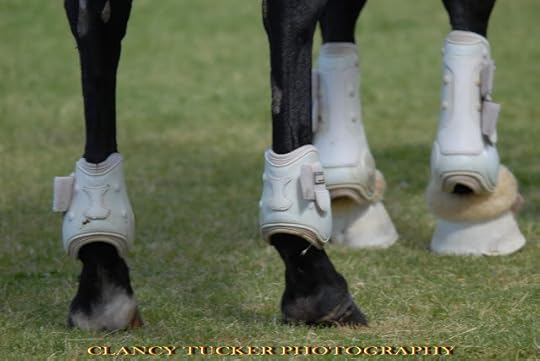
Published on September 15, 2018 16:51
September 14, 2018
15 September 2018 - WEIRD AND WONDERFUL STUFF
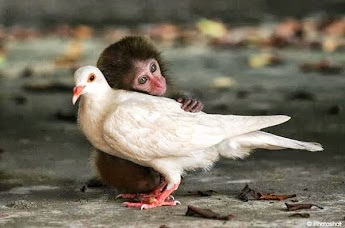
WEIRD AND WONDERFUL STUFF
G'day folks,
Welcome to some great, weird and wonderful stuff.

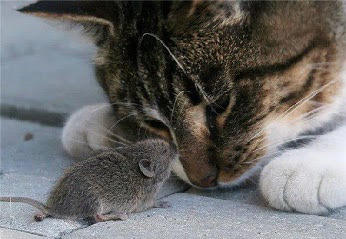
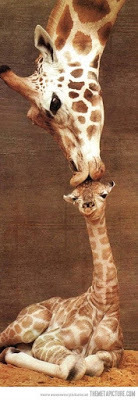
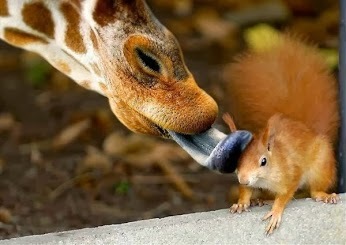




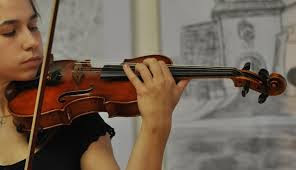


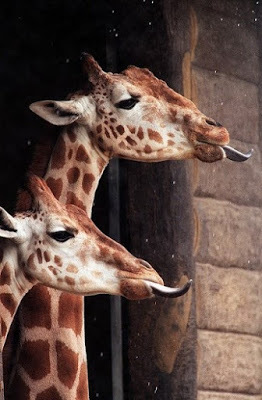
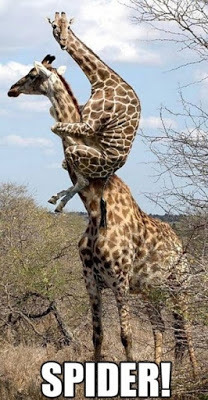


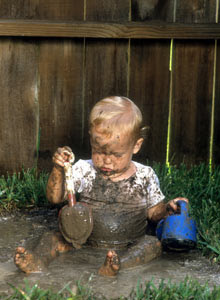



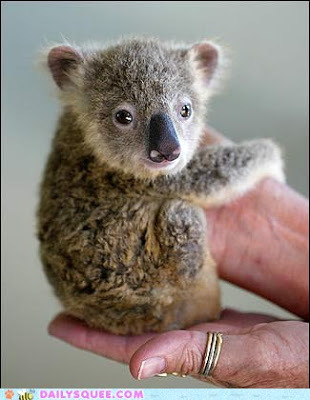

Clancy's comment: I love to see any kid reading a book, playing outside, and playing a musical instrument.
I'm ...


Published on September 14, 2018 15:26
September 13, 2018
14 September 2018 - FACTS ABOUT THE AMAZING PEREGRINE FALCON
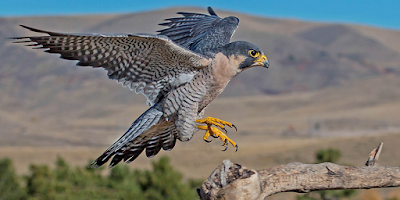
FACTS ABOUT THE AMAZING PEREGRINE FALCON
G'day folks,
Here are some staggering facts about the peregrine falcon which is the fastest animal on the planet. In a ‘stoop’ they can reach up to speeds of 290km/h.
The Peregrine Falcon is a powerful bird of prey, or raptor, that specialises in hunting other birds by diving at them in a high speed dive (called a 'stoop'). Although widespread throughout the world, they are not a common species. They are native to Australia and are rare across all states and territories.

Quick Facts
Type: BirdDiet: CarnivoreLifespan: Around 7-15 yearsSize: 40-46 cm with wingspan of 95-110 cmWeight: Male 330-1000 g; female 700-1500 gWeight: Male 330-1000 g; female 700-1500 gRange: Europe, Asia, North and South America, Africa and Australasia.Scientific name: Falco peregrinusThe peregrine falcon is perhaps the best hunter of the falcon family. It hunts in wild uplands and rocky coasts, scanning the landscape for prey with its exceptional eyesight.Their eyes are larger and heavier than human eyes and they can spot prey on the ground from a great height of 300m.Soaring through the sky on broad, pointed wings, the streamlined peregrine falcon is a most impressive sight as it hunts down small birds. The force and impact of its breathtaking ‘stoop’ – a sheer, high-speed dive – is often enough to kill a victim outright while still in mid-air.The peregrine’s courtship involves the male passing food to the female, often when in flight. To make this manoeuvre possible, the female will roll over when flying to take the offered food from his talons.Peregrine falcon chicks mature quickly. They have tremendous appetites and double their weight in just around 6 days. At three weeks of age they are already around 10 times their size at birth.The male peregrine is called a ‘tiercel’ because it is a tierce (one third) smaller in size than the female.Peregrines will often return to the same eyrie (nest) each year.The peregrine falcon is the fastest animal on the planet. In a ‘stoop’ they can reach up to speeds of 290km/h.

Threats to the Peregrine FalconDuring the Second World War peregrines were deliberately shot down in case they caught carrier pigeons which were delivering messages.Today, the main threat to peregrines is chemical pollutants, which they ingest from their prey and are highly sensitive too. The introduction of pesticides such as DDT saw numbers in Britain decline considerably. These poisons do not break down in the environment. Instead they accumulate in the food chain and birds such as falcons inevitably take in large quantities of such toxic substances. This greatly diminished their breeding success. However, restrictions on the use of agricultural chemicals and legislation to protect the species mean that numbers have now begun to recover.


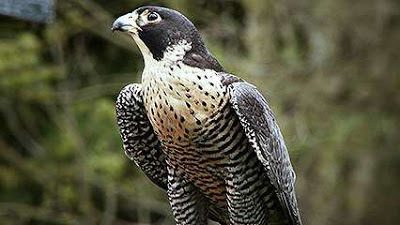

Clancy's comment: Again, an extraordinary creature. I recently saw a documentary about these in Italy. Amazing skills.
I'm ...


Published on September 13, 2018 13:35
September 12, 2018
13 September 2018 - THE GLAMOROUS BEACH PYJAMA
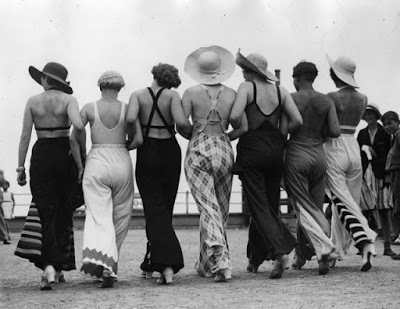
THE GLAMOROUS BEACH PYJAMA
G'day folks,
Before the bikini, fashionable ladies donned “beach pyjamas” all along the world’s most stylish coastal towns. The swishy palazzo-like pants and jumpsuit styles shocked the public in the interwar years, while we, on the other side of the second millennium, find some serious beach-going inspiration.
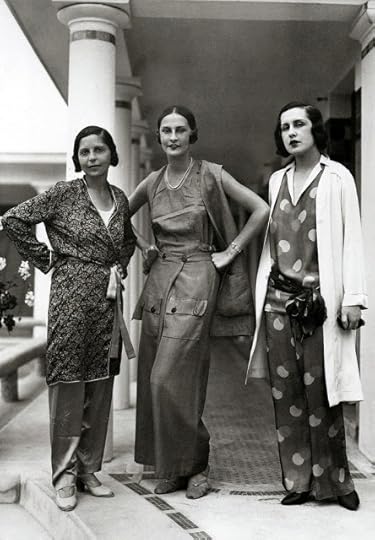
But what made the “beach pyjama” so shocking? As with much of 1920s women’s dress, it crossed gender lines. Up until this point, only men wore the “pyjama” style—a lightweight style fitted with drawstring waistbands adopted by British colonial powers from Indian Muslims in the 1800s. The English word itself, pyjama, derives from pāy-jāma in the Urdu language, which was borrowed from the Persian pāy-jāmeh, meaning ‘leg garment’ and unrelated to sleeping.


Ladies of the time, at least in these same colonised territories, almost exclusively wore night gowns for sleepwear and dresses or skirt sets of varying shapes during the day. With the beach pyjama however, the “modern girl” could roam beach-side towns with greater freedom, walking unhindered by sand and sun.
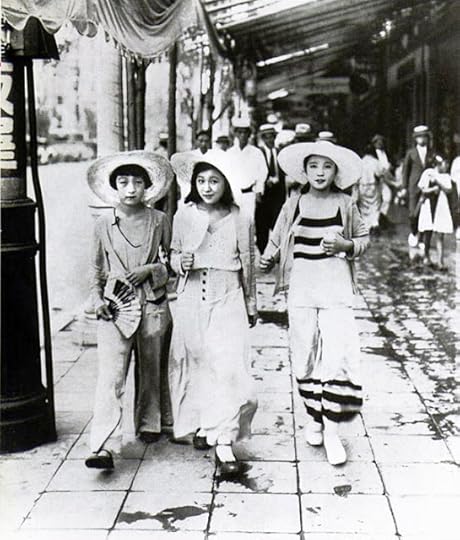
The 40s saw a regression from androgynous beachwear styles like the beach pyjama in favor of more effeminate silhouettes, like the bikini. But the glamourous 1930s fashion left a legacy beyond the Riviera’s sandy shores. It influenced wide-leg pant styles for decades to come, including the “palazzo” pant of the 60s.

Some might also remember the days of “hostess pyjamas”; from the 1930s through the 1970s, women might wear hostess pyjamas while entertaining in their homes when they wanted to impart a casual and relaxed atmosphere for their guests.
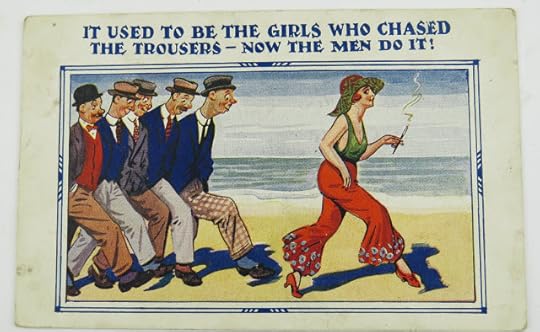
Love it or hate it, pyjama fashion will likely not be disappearing anytime soon, which is good news for the avant-garde vacationers or fashionistas in our midst. And as Coco Chanel once said, “It is always better to be slightly underdressed.”

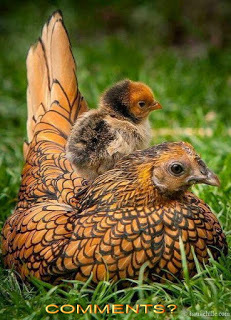
Clancy's comment: Mm ... Fashion is a multi-billion dollar business. Check out your wardrobe. One of your old favourites might be back in fashion.
I'm ...


Published on September 12, 2018 15:37
September 11, 2018
12 September 2018 - MOVING PICTURES

MOVING PICTURES
G'day folks,
Check out these fine moving pictures.












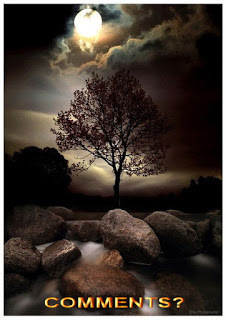
Clancy's comment: Loved the lamb and the dog.
I'm ...

Published on September 11, 2018 14:06



